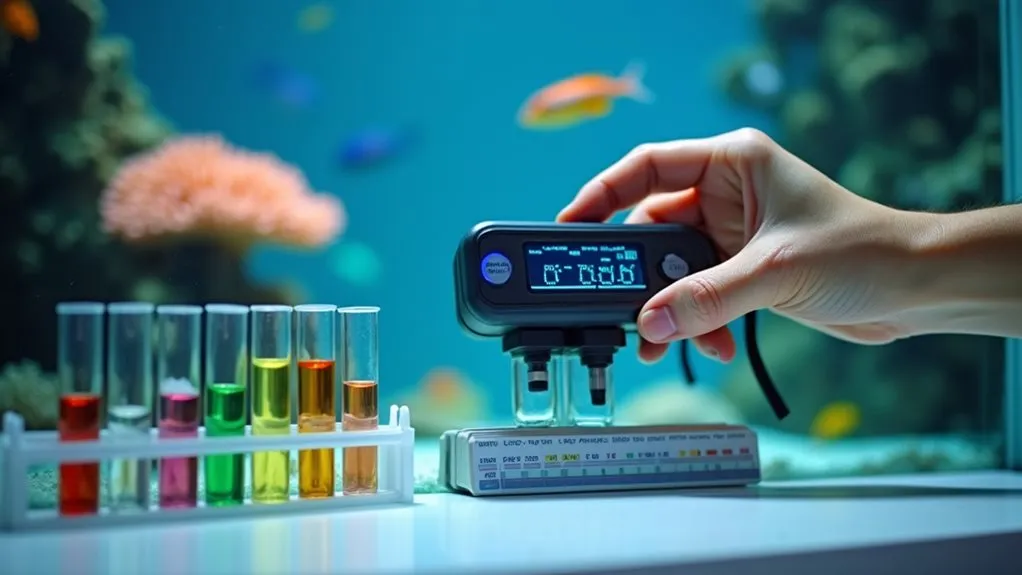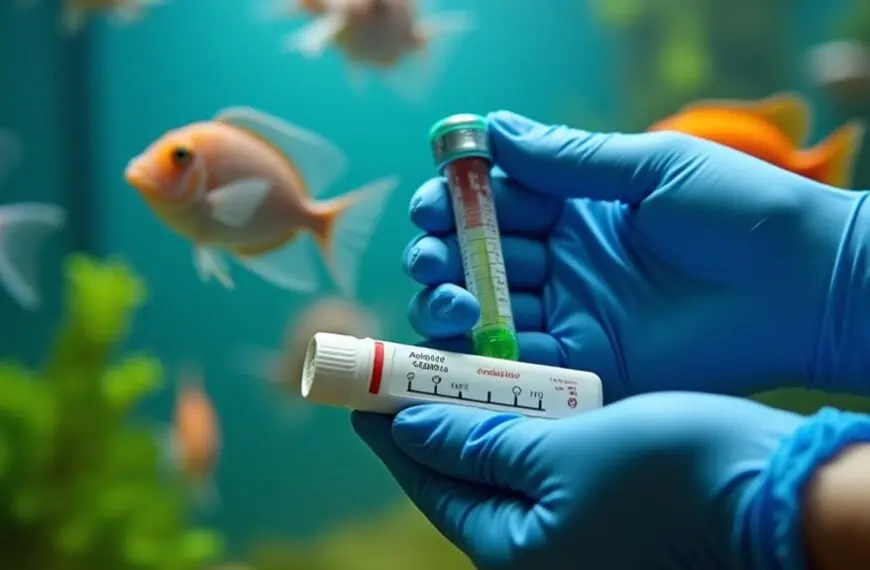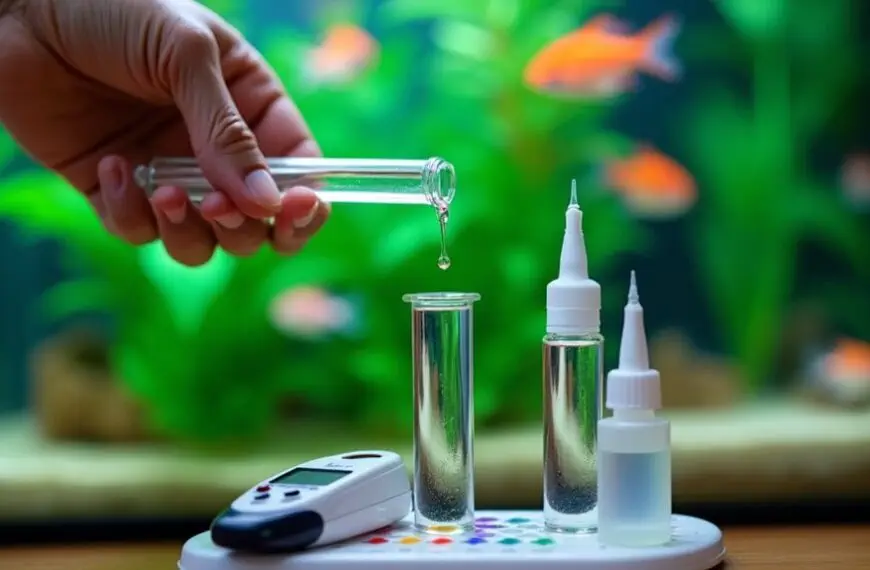For accurate saltwater aquarium pH testing, you’ll need the right equipment first—either test kits or digital meters. Test with clean hands and sample containers, following instructions precisely. Monitor new tanks daily and established ones weekly, keeping a log of results. Aim for 8.1-8.4 in reef tanks or 7.8-8.2 in fish-only setups, remembering that stability trumps perfection. If adjustment’s needed, natural methods like crushed coral offer the safest approach to maintaining your underwater world.
Contents
Understanding the Importance of Correct Ph Levels
The ocean’s delicate balance serves as the perfect template for your saltwater aquarium. When you maintain proper pH levels, you’re honoring this natural blueprint that keeps marine life thriving.
Your fish, corals, and invertebrates have evolved over millions of years to flourish within specific pH ranges—typically between 8.1 and 8.4 for most reef tanks.
The pH impact on your aquarium can’t be overstated! When levels drift too high or low, you’ll notice stressed fish, poor coral growth, and even equipment issues.
Think of pH as your tank’s crucial sign, much like your own pulse or temperature. It’s that important!
Testing regularly isn’t just busywork—it’s your early warning system. You wouldn’t ignore your car’s check engine light, right?
Don’t ignore your aquarium’s pH signals either!
Choosing the Right Ph Testing Equipment
When diving into the world of pH testing, you’ll quickly discover that not all equipment delivers the same reliability and precision your aquatic friends deserve.
Your choice fundamentally boils down to traditional pH test kits or digital pH meters, each with distinct advantages.
Test kits are budget-friendly and provide the basics you need, perfect for beginners who are just getting their feet wet. They use color-changing reagents that you’ll match to a chart—simple but effective!
Digital pH meters, while pricier, offer spot-on accuracy and instant readings that eliminate the guesswork of color matching. They’re a fantastic investment if you’re serious about maintaining ideal conditions.
Step-By-Step Ph Testing Process
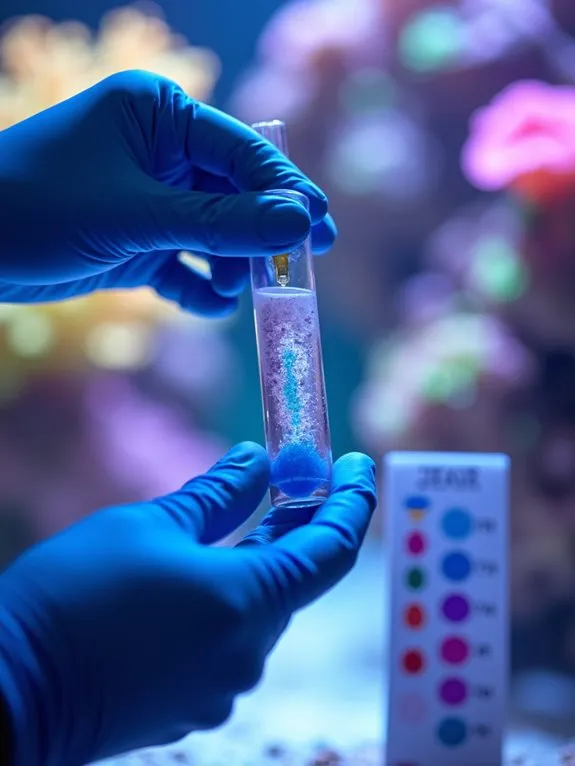
Diving into your testing routine doesn’t need to feel like rocket science, even if you’re measuring something as critical as pH.
With consistency, you’ll master this quickly!
First, confirm your hands are clean and dry before handling test kits. Remove a water sample from your tank using a dedicated container, not one that’s had chemicals in it.
Follow your test kit’s instructions precisely—timing matters when reagents react with your sample.
Your testing frequency should align with your tank’s stability. New setups need daily checks, while established tanks might only require weekly monitoring.
Keep a log to track pH fluctuations, which can reveal potential problems before they become catastrophes.
Interpreting Your Ph Test Results
Once you’ve recorded your pH readings, it’s time to make sense of those colorful test results staring back at you. Most reef tanks thrive in the 8.1-8.4 range, while fish-only setups do well between 7.8-8.2.
Don’t panic over small fluctuations—they’re normal throughout the day!
One of the common pH misconceptions is that you need to chase a “perfect” number. Your animals care more about stability than hitting exactly 8.2. If your pH sits consistently at 7.9, that’s likely better than bouncing between 8.0-8.4 daily.
As for pH test accuracy, those test kits aren’t infallible! Expired reagents, contaminated test tubes, or even your home lighting can skew results.
If something seems off, try testing your aquarium water with two different kits for comparison.
Natural Methods to Safely Adjust Saltwater Ph
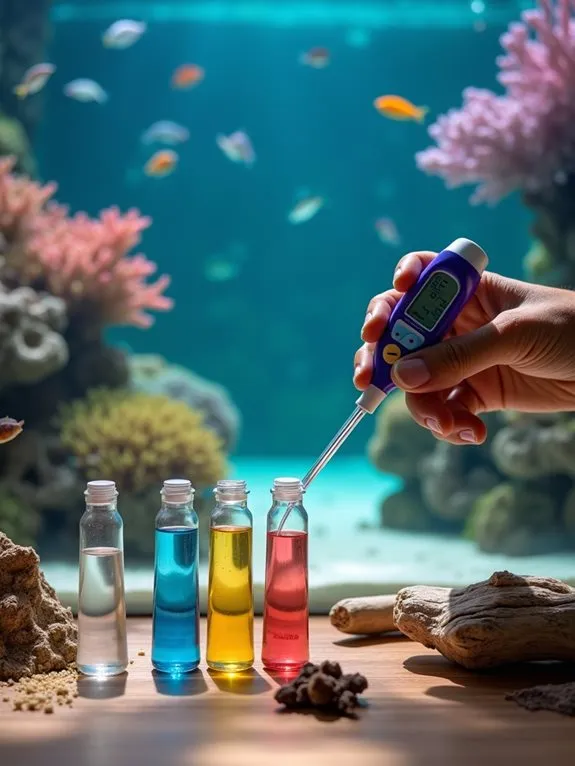
As reef keepers search for gentler ways to maintain water chemistry, natural pH adjustment methods have become increasingly popular.
You’ll find that natural buffers like crushed coral, aragonite sand, and limestone rock can gradually raise pH levels without the harsh swings that chemical additives sometimes cause.
When your pH dips too low, try adding a small mesh bag of crushed coral to your filter system—it slowly dissolves as needed.
For tanks running high, increasing water flow and aeration helps release excess CO2, naturally bringing pH back to healthy levels.
Remember, patience is key with natural approaches!
Weekly water changes using properly prepared saltwater remain your best tool for maintaining stable pH.
Your corals will thank you for choosing these gentler methods over reactive chemical solutions.
Frequently Asked Questions
How Often Should I Test My Saltwater Aquarium Ph?
You should test your saltwater aquarium pH at least once a week. If you’re dealing with pH stability issues or have new additions, increase your testing frequency to every 2-3 days until conditions normalize.
Can Ph Fluctuations Kill My Coral or Fish?
Yes, pH fluctuations can damage your coral health and cause fish stress. You’ll notice your corals closing up and fish gasping at the surface. Rapid changes are more harmful than gradual ones.
Does Temperature Affect Ph Readings in Saltwater Tanks?
Yes, temperature greatly affects pH readings in saltwater tanks. You’ll notice temperature effects can shift results by 0.1-0.3 units. For best testing accuracy, always measure pH at your tank’s stable operating temperature.
Why Does My Ph Drop Overnight in My Reef Tank?
Your pH drops overnight because of nighttime oxygen depletion when photosynthesis stops. You’ll need pH stabilization methods like better water circulation or adding buffer solutions to maintain consistent levels in your reef tank.
Should Ph Levels Differ for Fish-Only Versus Reef Aquariums?
Yes, pH levels differ slightly. Reef tanks need higher, more stable pH (8.1-8.4) for coral requirements, while fish-only setups can tolerate wider ranges (7.8-8.2) based on fish compatibility with your specific species.
Final Thoughts
You’re now equipped with the know-how to master pH testing in your saltwater aquarium! Remember, consistent monitoring is your secret weapon for keeping your underwater friends healthy and thriving. Don’t stress if you need to make adjustments – small, gradual changes are always best. With these five essential tips in your toolkit, you’ll maintain that perfect pH balance and enjoy a vibrant, colorful aquarium that’s the envy of fellow fish enthusiasts!

